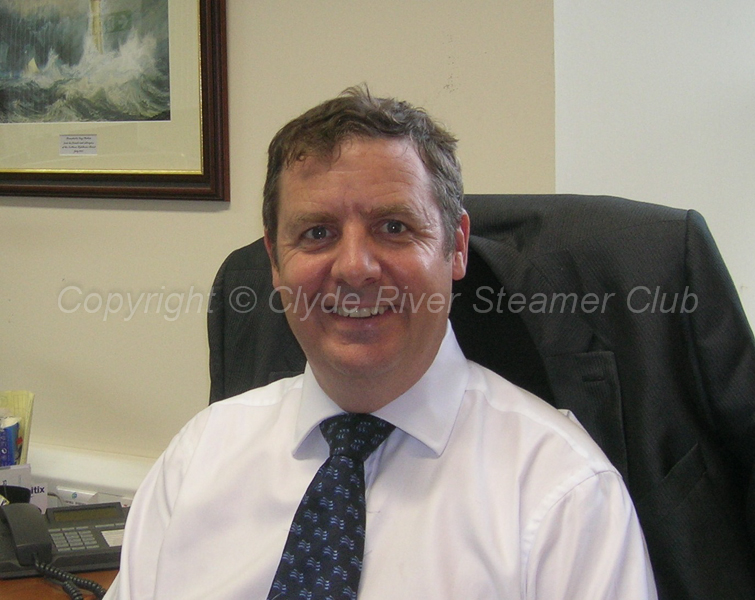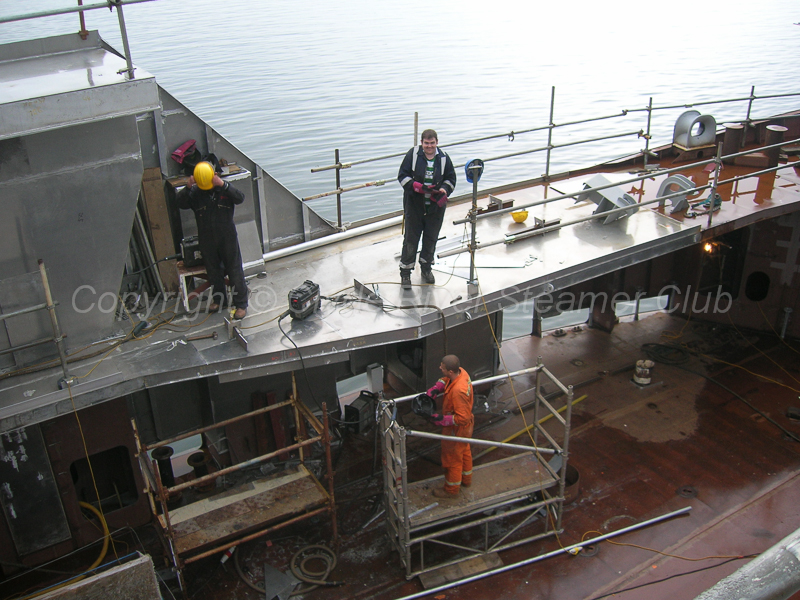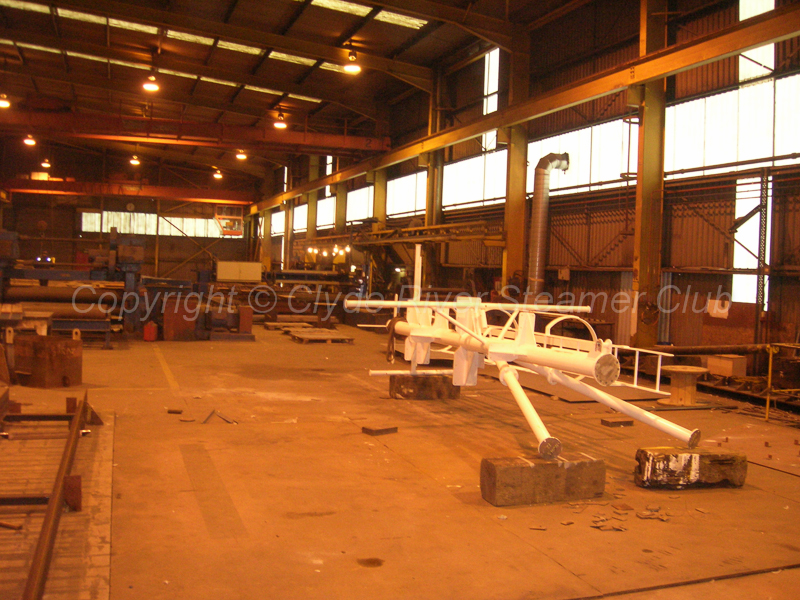Interview with Guy Platten, Chief Executive of Caledonian Maritime Assets Ltd (CMAL)
In the second of a series of articles marking CalMac’s 40th anniversary, crsc.org.uk talks to Guy Platten about CMAL’s investment plans. Since its formation by the Scottish government in 2006, the company has been the owner of Clyde and Hebridean ferries and piers, which it leases to an operating company, CalMac Ferries Ltd.
Key points of the interview:
● CMAL aims to pioneer the use of hydrogen power in ferries as part of its drive to develop environmentally friendly energy sources
● An ERDF grant towards the cost of the Hallaig and Lochinvar shows potential for EU investment in Clyde-based ferry technology
● The Hallaig, first of the ‘hybrid’ ferries, will spend a month on proving trials at Raasay before entering service in mid-September
● The new Loch Seaforth, due to enter service on the Stornoway run next summer, will be a diesel-electric/diesel-mechanical hybrid
● CMAL’s next big ferry, due for the Arran run in 2017, could be one of a set of near-identical vessels, leading to design economies
● The contract for a new £18m pier at Brodick will be put to tender next summer, with construction due to finish early in 2016
● Scotland’s “two-leg” structure of ferry ownership/operation is “a model that seems to work” and promotes long-term investment
Alsterwasser in Hamburg,
the world’s first hydrogen-powered ferry to carry 100 passengers
Scotland could become a pioneer of hydrogen-powered ferries, if plans revealed by Caledonian Maritime Assets Ltd come to fruition.
The plans were outlined by Guy Platten, CMAL chief executive, in an interview with crsc.org.uk.
Guy Platten at his desk in CMAL’s
open-plan headquarters at Port Glasgow
Speaking at the company’s Port Glasgow headquarters, Mr Platten said hydrogen-powered buses were already in use in Aberdeen and London, and CMAL was exploring the possible application of hydrogen fuel to marine technology. It could result in the west of Scotland producing the world’s first zero-carbon car ferry — a vessel operating without fossil fuels.
Mr Platten, 49, who has been CMAL chief executive since 2007, said an initial study had been undertaken in conjunction with St Andrews University and Scottish Enterprise. The project is to be explored at a deeper level in a year-long feasibility study, with partners including BAE Systems, Ballard Power Systems and Transport Canada. If successful, it would represent a significant advance on the environment-friendly technology pioneered by the Hallaig and Lochinvar, CMAL’s ‘hybrid’ ferries nearing completion at Ferguson Shipbuilders, Port Glasgow.
“Our initial study showed it would be possible to build a Hallaig [type of ferry] powered totally from renewable sources,” he said. “A sea-going, hydrogen-powered vessel would be even more ground-breaking than our new ‘hybrid’ ferries. What we need is a much more detailed study to look at the whole picture, including the shore supply chain.”
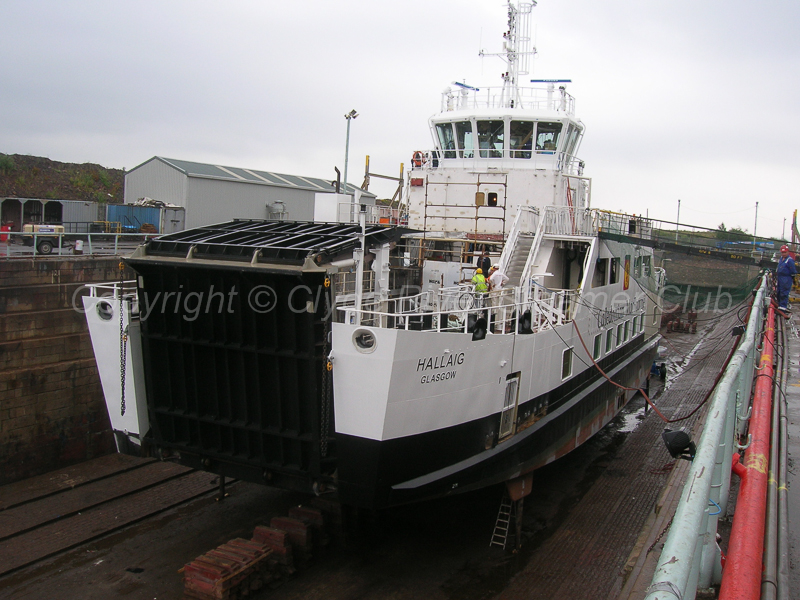 |
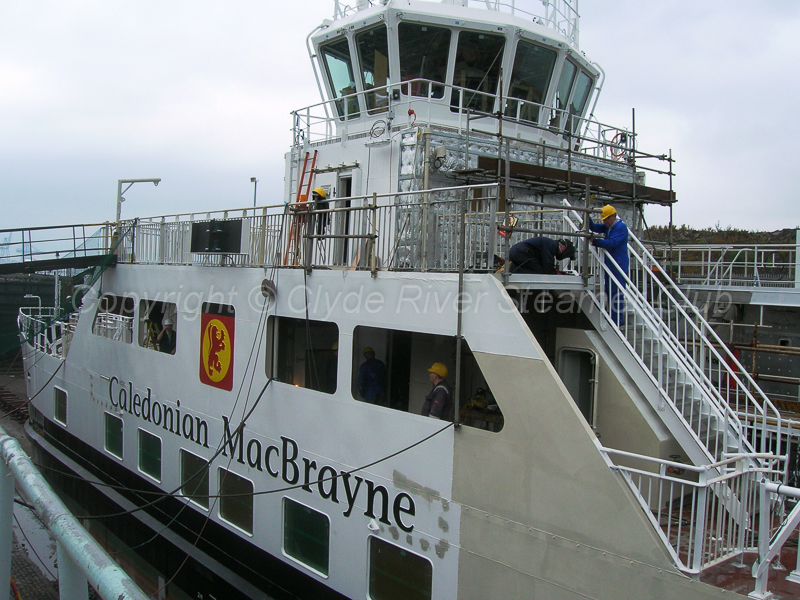 |
|
| Hallaig at Garvel Dry Dock in July 2013
|
Hallaig receives finishing touches during dry-docking at Garvel Clyde |
Outlining the challenges involved in such a project, Mr Platten said CMAL envisaged a budget of £20m for a hydrogen-powered prototype — double the cost of a ‘hybrid’ ferry (£10m), which was already £2m more expensive than a conventional diesel-driven ferry. “But the price will fall. As with all new technology, the more you do it, the cheaper it becomes. At present it does not make a strong business case: we’re thinking more of the research and development case. Ship technology emanated from Scotland, in the shape of the Comet, and someone has to be the prime mover. CMAL is taking the long view, not a short-term commercial view. We want Scotland to remain at the forefront [of marine technology] and to show that a sea-going hydrogen-powered ferry is possible.”
Hydra, an experimental hydrogen-powered boat
which made its debut in Germany in 2000
The world’s first hydrogen boat, power-assisted by an electric motor deriving its electricity from a fuel cell, was trialled on the River Rhine in Germany in 2000. An 18-person hydrogen-powered water-taxi entered service at San Francisco in 2003, since when there have been several other experiments, driven by an increasing awareness that diesel ships are one of the biggest sources of air pollution. But the means of harnessing hydrogen power for larger ships on the open sea have yet to be worked out — partly because of the huge development cost and partly because of difficulties in devising sufficient on-board storage space for hydrogen fuel.
In its bid to solve these problems and be first off the mark, CMAL’s Scottish-based consortium has entered a neck-and-neck race with Germany, where development projects are already underway. CMAL, which is owned by the Scottish government, hopes a £450,000 European Regional Development Fund grant towards the cost of its two ‘hybrid’ ferries can be a first step to unlocking European funds for its hydrogen project.
Mr Platten said political support was essential, and there had been a “big buy-in” by the Scottish government. But he rejected the suggestion that CMAL’s quest for CO2-free ships was politically driven. “You can be cynical [about CMAL’s embrace of environment-friendly technology], and we don’t yet know what the full benefits will be, but it must be tried, because we do believe it will save on fuel and emissions. That’s enough in itself — the positives outweigh the negatives. The project has already safeguarded 120 jobs. It is promoting Scotland. It has brought [merchant] shipbuilding back to the Clyde. That is something we can all be proud of.”
Richard Deane,
Managing Director of Fergusons Shipbuilders
The next 12 months will be crucial in determining the success of CMAL’s experiment with low-carbon power — a hybrid of diesel electric and lithium ion battery power, specially devised for the Hallaig and Lochinvar. After sea trials on the Clyde in mid-August the Hallaig will head north to Sconsor for a month of proving trials — long by conventional standards — to iron out any problems her new technology may throw up. She is expected to enter service on the Raasay run in mid-September, with the Lochinvar due to follow on the Tarbert-Portavadie service about three months later. CMAL hopes that, once the two ferries have proven their reliability, they will be able to operate entirely off their batteries during some of the quieter winter weeks.
The £20m cost of the two ferries was funded by a 100 per cent loan from the Scottish government, which will be repaid out of CMAL’s revenue. The new £42m Stornoway ferry Loch Seaforth, by contrast, has been financed through a leasing structure with Lloyds Banking Group, in an arrangement not dissimilar to a conventional car lease. Mr Platten said it was part of CMAL’s remit to identify funding sources, “and Lloyds had the appetite to do this kind of arrangement. We’re not paying through the nose — it’s a very competitive rate. It’s a good transaction in today’s market.”
Currently under construction at Flensburg, Germany, and due to enter service in June 2014, the Loch Seaforth — designed for round-the-clock operation — will be a hybrid of diesel-mechanical and diesel-electric power. “As well as the two main [diesel] engines, she will have three [electric] generators which can be linked into the whole system,” Mr Platten explained. “This will allow flexibility of operation, so that you can take down one engine for repair while maintaining the service.”
He said CMAL’s next challenge was to build a new vessel for Ardrossan-Brodick, as called for in Transport Scotland’s Ferries Plan. The ship would serve as consort to the Caledonian Isles. “We want to place an order in 2014 and hopefully take delivery in 2017. The vessel for Arran could also be suitable for Mull. We could build a series of ships, which would be far more economical [than a succession of one-off designs, as was the case in the 1980s and 1990s].”
Mr Platten said CMAL turnover was around £22m, but its payroll was still only 20 (it started with five in 2006). The company had appointed a harbourmaster at the beginning of 2012 to supervise safety at its harbours, and it now had a team of civil engineers to monitor maintenance and capital requirements.
Andrew Flockhart, CMAL head of business development,
and James Anderson, project manager for new builds
A recent priority had been the reconstruction of Kennacraig, which involved widening the causeway to two lanes and reclamation work to increase the size of the marshalling area. The work would be completed by the end of 2013. There were also plans to replace the older of the two Oban linkspans.
 |
 |
|
| The marshalling area at Kennacraig is undergoing extensive redevelopment |
Oban’s original linkspan is to be renewed |
As for the new two-berth pier at Brodick, the project was now in its design and development phase, and would go to tender in late spring or early summer of next year, with a view to work starting on-site at the end of 2014 or early 2015. The structure, a long pier with a berth on either side, would take a year to build, and should be ready for use in early 2016. Mr Platten said the £18m project involved a “complete redevelopment of the port”, with a new terminal building, a linkspan berth dedicated to the Arran ferry and a second, concrete berth suitable for cruise and cargo ships. The historic pier site “will change beyond recognition”.
 |
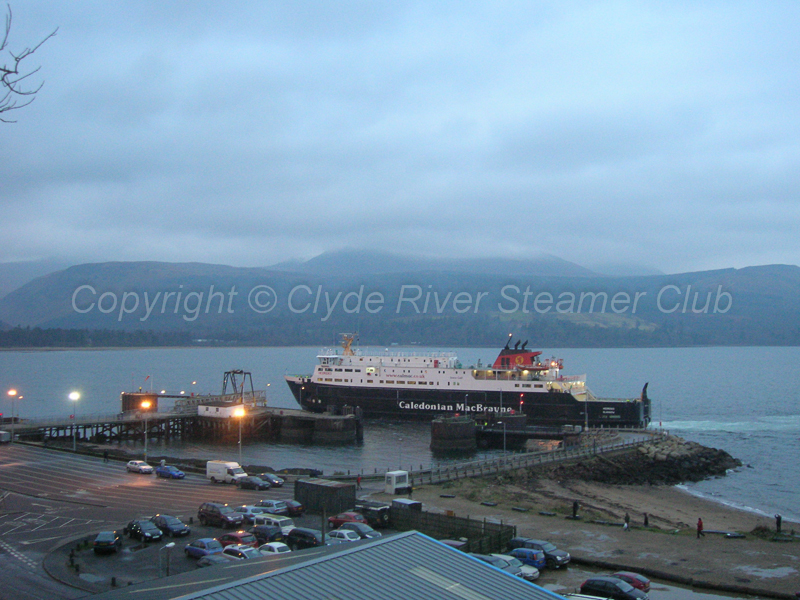 |
|
| Isle of Arran, consort to the Caledonian Isles, will be replaced by a new ferry in 2017 |
The pier and terminal area at Brodick are to be completely redeveloped |
Mr Platten defended the “two-leg” division of ship/harbour ownership and ferry operation that had been in force in the west of Scotland since 2006, arguing that it encouraged long-term investment. “It is a good model, because it means the Scottish community has the security of the assets. Some other European countries have not had the same good fortune. We have done a huge amount of work on the piers: asset management is a unique skill, entirely separate from ferry operation.”
Asked for his thoughts on the possibility of CalMac losing out to another bidder in the Scottish government’s upcoming tender process, Mr Platten said that despite occasional tensions “which can be healthy”, CMAL and CalMac worked well together. “I wish CalMac luck and every success in its bid for the next tender.”
Guy Platten was speaking to CRSC magazine editor Andrew Clark at the end of July 2013.
This is the second interview in a series marking CalMac’s 40th anniversary.
The first, featuring CalMac Managing Director Martin Dorchester, can be read here.
A CMAL video about the two new ‘hybrid’ ferries can be seen here.
Sign up for CRSC membership and further your interest in Scottish shipping.












